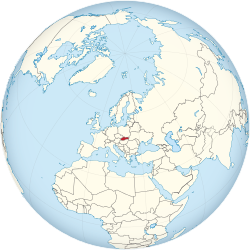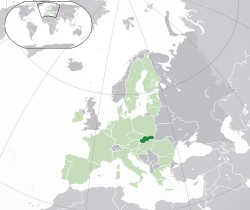
Back Словакиа Abkhazian Slowakia ACE Словакие ADY Slowakye Afrikaans Slowakei ALS ስሎቫኪያ Amharic Slovakia AMI Eslovaquia AN Slofacia ANG स्लोवाकिया ANP
Slovak Republic Slovenská republika (Slovak) | |
|---|---|
| Anthem: Nad Tatrou sa blýska (Slovak) "Lightning over the Tatras" | |
| National seal | |
Location of Slovakia (dark green) – in Europe (green & dark grey) | |
| Capital and largest city | Bratislava 48°09′N 17°07′E / 48.150°N 17.117°E |
| Official languages | Slovak |
| Ethnic groups (2021)[1] |
|
| Religion (2021)[2] |
|
| Demonym(s) | Slovak |
| Government | Unitary parliamentary republic |
| Peter Pellegrini | |
| Robert Fico | |
| Peter Žiga | |
| Legislature | National Council |
| Establishment history | |
| 28 October 1918 | |
| 4 June 1920 | |
| 30 September 1938 | |
| 14 March 1939 | |
| 24 October 1945 | |
| 25 February 1948 | |
| 11 July 1960 | |
• Slovak Socialist Republic (within Czechoslovak Socialist Republic, change of unitary Czechoslovak state into a federation) | 1 January 1969 |
• Slovak Republic (change of name within established Czech and Slovak Federative Republic) | 1 March 1990 |
| 1 January 1993 | |
| Area | |
• Total | 49,035 km2 (18,933 sq mi) (127th) |
• Water (%) | 0.72 (2015)[3] |
| Population | |
• 30 June 2024 estimate | |
• 2021 census | |
• Density | 110/km2 (284.9/sq mi) (103rd) |
| GDP (PPP) | 2025 estimate |
• Total | |
• Per capita | |
| GDP (nominal) | 2025 estimate |
• Total | |
• Per capita | |
| Gini (2022) | low inequality |
| HDI (2022) | very high (45th) |
| Currency | Euro (€) (EUR) |
| Time zone | UTC+1 (CET) |
• Summer (DST) | UTC+2 (CEST) |
| Date format | d. m. yyyy |
| Drives on | Right |
| Calling code | +421 |
| ISO 3166 code | SK |
| Internet TLD | .sk and .eu |
Slovakia,[a] officially the Slovak Republic,[b] is a landlocked country in Central Europe. It is bordered by Poland to the north, Ukraine to the east, Hungary to the south, Austria to the west, and the Czech Republic to the northwest. Slovakia's mostly mountainous territory spans about 49,000 square kilometres (19,000 sq mi), hosting a population exceeding 5.4 million. The capital and largest city is Bratislava, while the second largest city is Košice.
The Slavs arrived in the territory of the present-day Slovakia in the 5th and 6th centuries. From the late 6th century, parts of modern Slovakia were incorporated in the Avar Khaghanate. In the 7th century, the Slavs played a significant role in the creation of Samo's Empire. In the 9th century, the Avar Khaghanate dissolved, and the Slavs established the Principality of Nitra, which was later conquered by the Principality of Moravia, leading to the formation of Great Moravia. In the 10th century, after the dissolution of Great Moravia, the territory was integrated into the Principality of Hungary at the end of the 9th century, which later became the Kingdom of Hungary in 1000.[12] In 1241 and 1242, after the Mongol invasion of Europe, much of the territory was destroyed, but was recovered largely thanks to Hungarian king Béla IV. During the 16th and 17th centuries, southern portions of present-day Slovakia were incorporated into provinces of the Ottoman Empire.[13][14] The Ottomans recognized the loss of territory by the Treaty of Karlowitz in 1699. Most of Hungary, including territories of present-day Slovakia, were reunited and came under Habsburg rule by the turn of the 18th century. Hungarian wars of independence against the Habsburgs in 1703–1711 and 1848–1849 resulted in a compromise that established the Austro-Hungarian Empire in 1867, a major power in the early 20th century.[15]
After World War I, the state of Czechoslovakia was established by the dissolution of the Austro-Hungarian Empire. Czechoslovakia incorporated Slovakia by the Treaty of Trianon in 1920 which area was entirely the territory of the Kingdom of Hungary. In the lead up to World War II, local fascist parties gradually came to power in the Slovak lands, and the first Slovak Republic was established as a clerical fascist client state under the control of Nazi Germany. In 1940, the country joined the Axis when its leaders signed the Tripartite Pact. Internal opposition to the fascist government's policies culminated in the Slovak National Uprising, itself triggered by the Nazi German occupation of the country.[16] Although the uprising was eventually suppressed, partisan resistance continued, and Czechoslovak independence was re-established after the country's liberation at the end of the war.
Following the Soviet-backed coup of 1948, Czechoslovakia became a communist state within the Eastern Bloc, a satellite state of the Soviet Union behind the Iron Curtain and member of the Warsaw Pact. Attempts to liberalise communism culminated in the Prague Spring, which was suppressed by the Warsaw Pact invasion of Czechoslovakia in August 1968. In 1989, the Velvet Revolution peacefully ended Communist rule in Czechoslovakia. Slovakia became an independent state on 1 January 1993 after the peaceful dissolution of Czechoslovakia, sometimes referred to as the Velvet Divorce.
Slovakia is a developed country with an advanced high-income economy. The country maintains a combination of a market economy with a comprehensive social security system, providing citizens with universal health care, free education, and one of the longest paid parental leaves in the OECD.[17] Slovakia is a member of the European Union, the Eurozone, the Schengen Area, the United Nations, NATO, CERN, the OECD, the WTO, the Council of Europe, the Visegrád Group, and the OSCE. Slovakia is also home to eight UNESCO World Heritage Sites. The world's largest per-capita car producer, Slovakia manufactured a total of 1.1 million cars in 2019, representing 43% of its total industrial output.[18]
- ^ "SODB2021 - Population - Basic results". Archived from the original on 4 November 2022. Retrieved 23 January 2022.
- ^ "SODB2021 - K rímskokatolíckemu vyznaniu sa prihlásilo 56 % obyvateľov". Archived from the original on 20 May 2022. Retrieved 20 January 2022.
- ^ "Surface water and surface water change". Organisation for Economic Co-operation and Development (OECD). Archived from the original on 24 March 2021. Retrieved 11 October 2020.
- ^ "Stock of population in the SR on 30 June 2024". slovak.statistics.sk. Statistical Office of the Slovak Republic. 30 August 2024. Retrieved 30 August 2024.
- ^ "2021 Population and Housing Census". scitanie.sk. Statistical Office of the Slovak Republic. 20 December 2021. Retrieved 19 September 2024.
- ^ a b c "World Economic Outlook Database, October 2024 Edition. (Slovakia)". www.imf.org. International Monetary Fund. 22 October 2024. Retrieved 29 November 2024.
- ^ Cite error: The named reference
IMFWEO.SKwas invoked but never defined (see the help page). - ^ "Gini coefficient of equivalised disposable income – EU-SILC survey". ec.europa.eu. Eurostat. Archived from the original on 9 October 2020. Retrieved 25 November 2023.
- ^ "Human Development Report 2023/2024" (PDF). United Nations Development Programme. 13 March 2024. Archived (PDF) from the original on 13 March 2024. Retrieved 13 March 2024.
- ^ Wells, John C. (2008), Longman Pronunciation Dictionary (3rd ed.), Longman, ISBN 978-1-4058-8118-0
- ^ Roach, Peter (2011), Cambridge English Pronouncing Dictionary (18th ed.), Cambridge: Cambridge University Press, ISBN 978-0-521-15253-2
- ^ Dixon-Kennedy, Mike (1998). Encyclopedia of Russian & Slavic myth and legend. ABC-CLIO. p. 375. ISBN 978-1-57607-130-4. Retrieved 23 April 2009.
- ^ Pirický, Gabriel (3 March 2023), "The Legacy of the Ottoman (Turkish) Age in Slovakia in the 21st Century", Europe’s Islamic Legacy: 1900 to the Present, Brill, pp. 29–47, doi:10.1163/9789004510722_004, ISBN 978-90-04-51072-2, retrieved 1 November 2024
- ^ Cite error: The named reference
:2was invoked but never defined (see the help page). - ^ "Austria-Hungary, HISTORICAL EMPIRE, EUROPE". Encyclopædia Britannica. 6 June 2017. Retrieved 6 June 2017.
- ^ "Slovaks condemn WWII deportations of Jews to Nazi death camps". PBS NewsHour. 25 May 2022. Archived from the original on 31 December 2023. Retrieved 31 December 2023.
- ^ "Which countries are most generous to new parents?". The Economist. Archived from the original on 4 November 2018. Retrieved 29 April 2017.
- ^ "Slovakia beats record in car production, again". 13 January 2020. Archived from the original on 13 December 2021. Retrieved 1 February 2020.
Cite error: There are <ref group=lower-alpha> tags or {{efn}} templates on this page, but the references will not show without a {{reflist|group=lower-alpha}} template or {{notelist}} template (see the help page).




